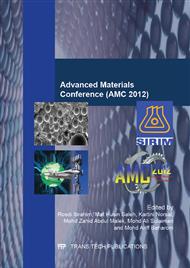[1]
K.Sanguansap, T. Suteewong, P. Saendee, U. Buranabunya, P. Tangboriboonraty, Composite natural rubber based latex particles: a novel Approach. Polymer 46 (2005) 1373-1378
DOI: 10.1016/j.polymer.2004.11.074
Google Scholar
[2]
A. Guyota, K.Landfesterb, F.J. Schorckc, C. Wang. Hybrid polymer latexes. Prog. Polym. Sci.,32 (2007), 1439-1461
Google Scholar
[3]
S. Shen, M. Yang, S. Ran, F. Xu and Z. Wang. Preparation and properties of natural rubber/polygorskite composites by co-coagulation rubber latex and clay aqueous suspension. Journal of Polymer Research 13 (2006) 469-473
DOI: 10.1007/s10965-006-9068-4
Google Scholar
[4]
Y. P. Wu, M. Q. Ji, Q.Qi, Y. Q. Wng, L. Q. Zhang. Chemically modified starch reinforced natural rubber composites. Macromol.Rapid Commun. 25 (2004) 565-570
DOI: 10.1002/marc.200300125
Google Scholar
[5]
M. Abdelmouleh, S. Boufi, M. N. Belgacem, A. Dufresne. Short natural-fibre reinforced polyethylene and natural rubber composites: Effect of silane coupling agents and fibres loading. Composite Science and Technology 67 (2007) 1627-1639
DOI: 10.1016/j.compscitech.2006.07.003
Google Scholar
[6]
G. R. Hamed, Reinforcement of rubber. Rubber Chem Technol 73 (2001) 524-33
Google Scholar
[7]
A. Y. Coran. Chemistry of the vulcanization and protection of elastomers: A review of the achievements. Journal Appl Polym Sci.,87 (2003) 24-30
Google Scholar
[8]
Xiao-Jun Xu and Leong Ming Gan. Recent advances in the synthesis of nanoparticles of polymer latexes with high polymer-to-surfactant ratios by microemulsion polymerization 10 (2005) 239-244
DOI: 10.1016/j.cocis.2005.09.002
Google Scholar
[9]
W. H. Ming, F. N. Jones, and S.K. Fu. Synthesis of nanosize poly (methyl methacrylate) microlatexes with high polymer content by a modified microemulsion polymerization. Polymer Bulletin 40 (1998) 749-756
DOI: 10.1007/s002890050318
Google Scholar
[10]
W. Jiang, W. Yang, X. B. Zeng, and S. K. Fu. Structure and properties of poly(methyl methacrylate) particle prepared by a modified microemulsion polymerization 42 (2003) 733-741
DOI: 10.1002/pola.10864
Google Scholar
[11]
S. Chuayjuljit and A. Boonmahithisud. Natural rubber blended with polystyrene nanoparticles prepared by differential microemulsion polymerization. Jurnal of Elastomers and Plastics 42 (2010) 375
DOI: 10.1177/0095244310371360
Google Scholar
[12]
L. Petersson and K. Oksman. Biopolymer based nanocomposites: comparing layered silicates and microcrystalline cellulose as nanoreinforcement. Sci. Technol., 66 (2006) 2187-2196.
DOI: 10.1016/j.compscitech.2005.12.010
Google Scholar


